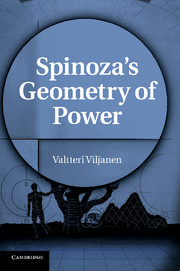Book contents
- Frontmatter
- Contents
- Acknowledgements
- Abbreviations
- Other sources
- Introduction
- Chapter 1 Spinoza on being
- Chapter 2 Causation and geometry
- Chapter 3 Power, existence, activity
- Chapter 4 The derivation of the conatus doctrine
- Chapter 5 The meaning of the conatus doctrine
- Chapter 6 Geometrical dynamics of individuality
- Conclusion
- Bibliography
- Index
Introduction
Published online by Cambridge University Press: 07 October 2011
- Frontmatter
- Contents
- Acknowledgements
- Abbreviations
- Other sources
- Introduction
- Chapter 1 Spinoza on being
- Chapter 2 Causation and geometry
- Chapter 3 Power, existence, activity
- Chapter 4 The derivation of the conatus doctrine
- Chapter 5 The meaning of the conatus doctrine
- Chapter 6 Geometrical dynamics of individuality
- Conclusion
- Bibliography
- Index
Summary
We must begin with two convictions prevalent in Western thought and old as philosophy itself, one that concerns us as cognitive beings, another the nature of reality itself. To take the better-known first: in geometry, the scientifically oriented human mind has found its apogee of clarity, lucidity, and certainty. Through the tumults that gave birth to the modern era, the status of geometry remained strong: nature itself was seen, to an increasing degree, in its terms. There is perhaps no more striking indication of this than the memorable passage in Galileo’s The Assayer of 1623:
Philosophy is written in this all-encompassing book that is constantly open before our eyes, that is the universe; but it cannot be understood unless one first learns to understand the language and knows the characters in which it is written. It is written in mathematical language, and its characters are triangles, circles, and other geometrical figures; without these it is humanly impossible to understand a word of it, and one wanders around pointlessly in a dark labyrinth. (EG, p. 183, emphasis added)
Only geometry is thus able to capture the very texture of nature: the universe is written with its characters. This spirit finds its way to the thought of Benedict de Spinoza (1632–77), who in his masterpiece, the Ethics, claims that however profound and intricate a question, it can be answered, but only after realizing a fundamental truth:
So they [men] maintained it as certain that the judgments of the Gods far surpass man’s grasp. This alone, of course, would have caused the truth to be hidden from the human race to eternity, if Mathematics, which is concerned not with ends, but only with the essences and properties of figures, had not shown men another standard of truth. (1app; C, p. 441; G ii, p. 79, emphasis added)
That the philosopher renowned for expressing his ideas in geometrical order has a high regard for mathematics is of course only what we should expect; but it should be appreciated that here geometry is not conceived of as a method or manner of exposition. Rather, it is the branch that has revealed the inner make-up of things. This idea manifests itself in various ways in Spinoza’s thought, and forms one of the recurring themes of this study.
- Type
- Chapter
- Information
- Spinoza's Geometry of Power , pp. 1 - 7Publisher: Cambridge University PressPrint publication year: 2011



